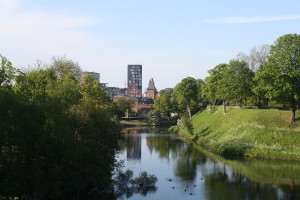Over the past few weeks, I’ve been looking at the issue of habitat fragmentation in respect to how it divides populations and presents barriers to animal movement which can limit reproductive success and gene flow. When I started gathering information on how to combat and mitigate habitat fragmentation, most of the resources I came across were focused on assessing degrees of fragmentation and looking at large scale policies- while that’s important for broader connectivity, it doesn’t necessarily translate into actions we can take on a regular basis. I took two lessons from this: A) we need to think outside the box for small scale options, and B) public policy will play a big role in how our landscape is connected in the future, so we need to make sure we tell those making the policies what we want. There are quite a few states and watershed areas (California, Washington, Colorado, the Rappahannock, etc.) with organizations specifically working to make habitat connectivity a general priority, so, if you do a little digging, you may find a local group you can support.
Here’s what I’ve managed to cobble together from a variety of sources as suggestions for limiting and reversing habitat fragmentation:
For animals that swim:
Culverts can increase water flow and their smooth sides don’t provide much to grasp- using bottomless versions gives animals protection from flow and better substrate as they cross.
In addition to the problems caused by canals and spoil banks, we create fragmentation when we force a boat through marshy areas- once we’ve loosened up the vegetation, tidal and wave action can cause erosion- or drag our anchor through a bed of seagrass. Sometimes the best option is to go around something.
Along a number of rivers, the dams which had originally been constructed to power mills and other machinery are no longer used, so there are organizations working to restore river access for fish species that needs to migrate upstream- check out Maine Audubon for some examples (plus they have a blog on habitat fragmentation).

Even within an urban environment, we can create habitat corridors that allow animals to move through the landscape
For animals that climb trees and fly:
Part of the challenge for these organisms is exposure to predators and to us when they cross open spaces, so keeping canopy gaps to a minimum can be helpful here- that means trees that are tall and close enough together for birds and gliding mammals so that they don’t have to use the ground.
If we want to keep insect pollinators moving from patch to patch and providing us with important ecosystem services, we need to ensure they have enough wildflower cover running along bare areas, otherwise they may just stay in one location (and the same is probably true for seed dispersers).
For animals that spend their time on the ground:
One of the biggest dangers here is crossing the road- I think that means that we need to be especially careful when we see signs indicating we’re in a wildlife crossing area (and we can help them across, too- salamander crossing guards are always appreciated in the spring!), and we need to create other options, like elevated crossings, so that animals don’t have to set foot on pavement to get across a road.
For animals in general:
The National Wildlife Federation has suggestions for turning whatever backyard/patio/road frontage area you have into better wildlife habitat (although you might not think of this as connecting habitat, for those species who now share our space with us, it can make a huge difference). They also have a document on the issue of urban sprawl that you may want to check out.
I’ve just scratched the surface here in terms of what we can do to lessen habitat fragmentation- if there is a species that you care about, learn about what that animal needs to survive and how much it needs to move around. With a little creativity you can start making changes in your community to help that species.
